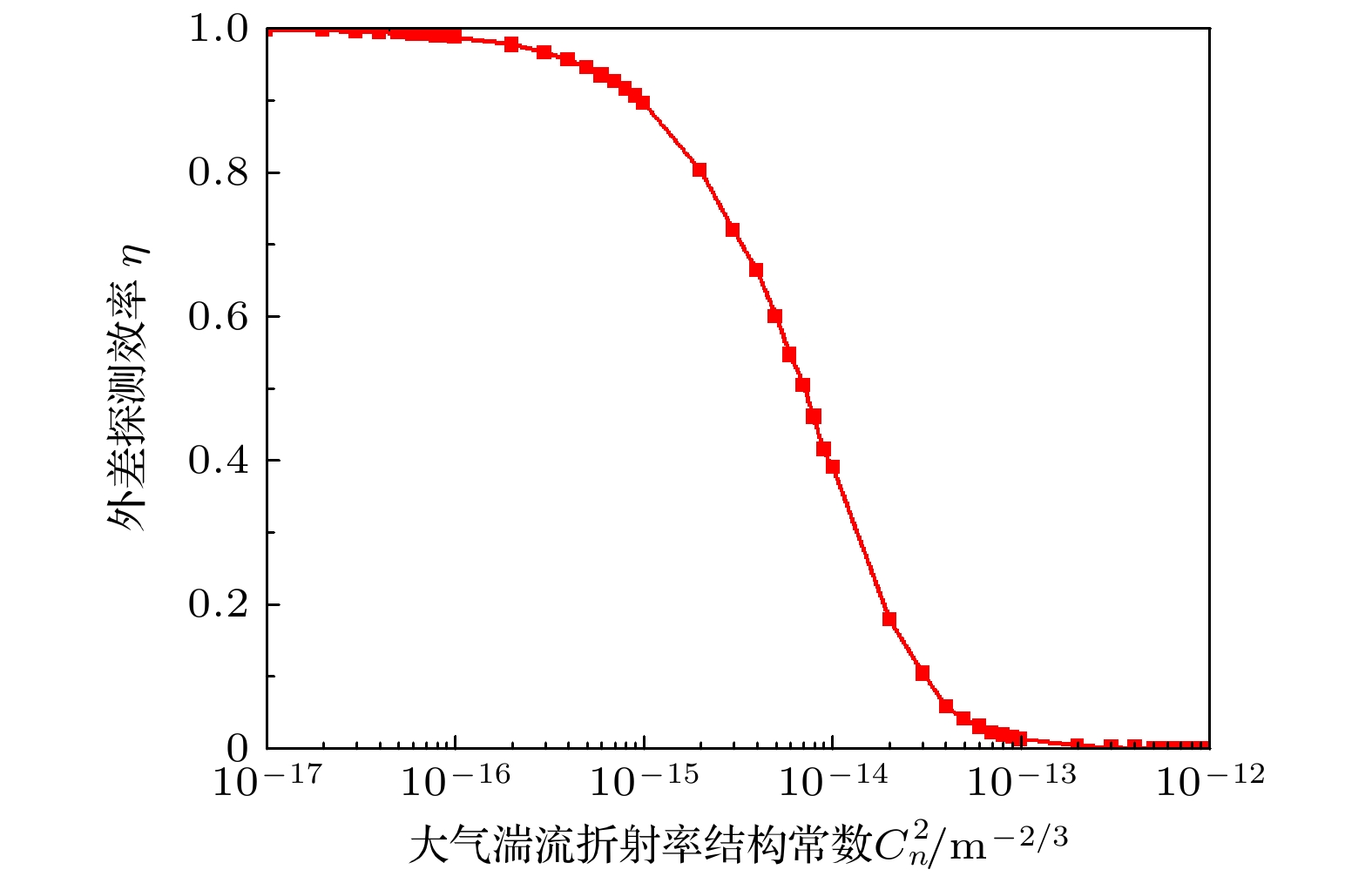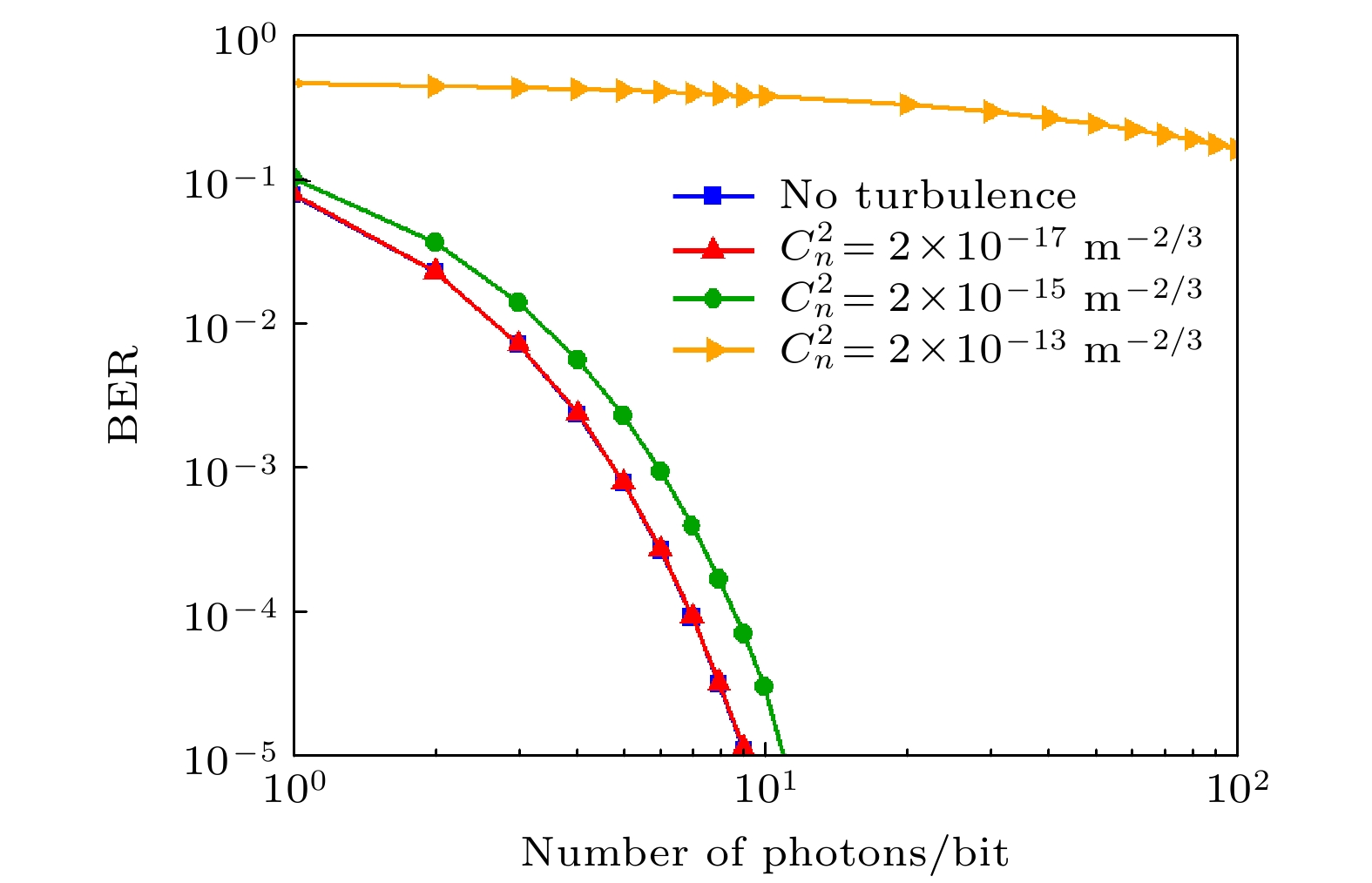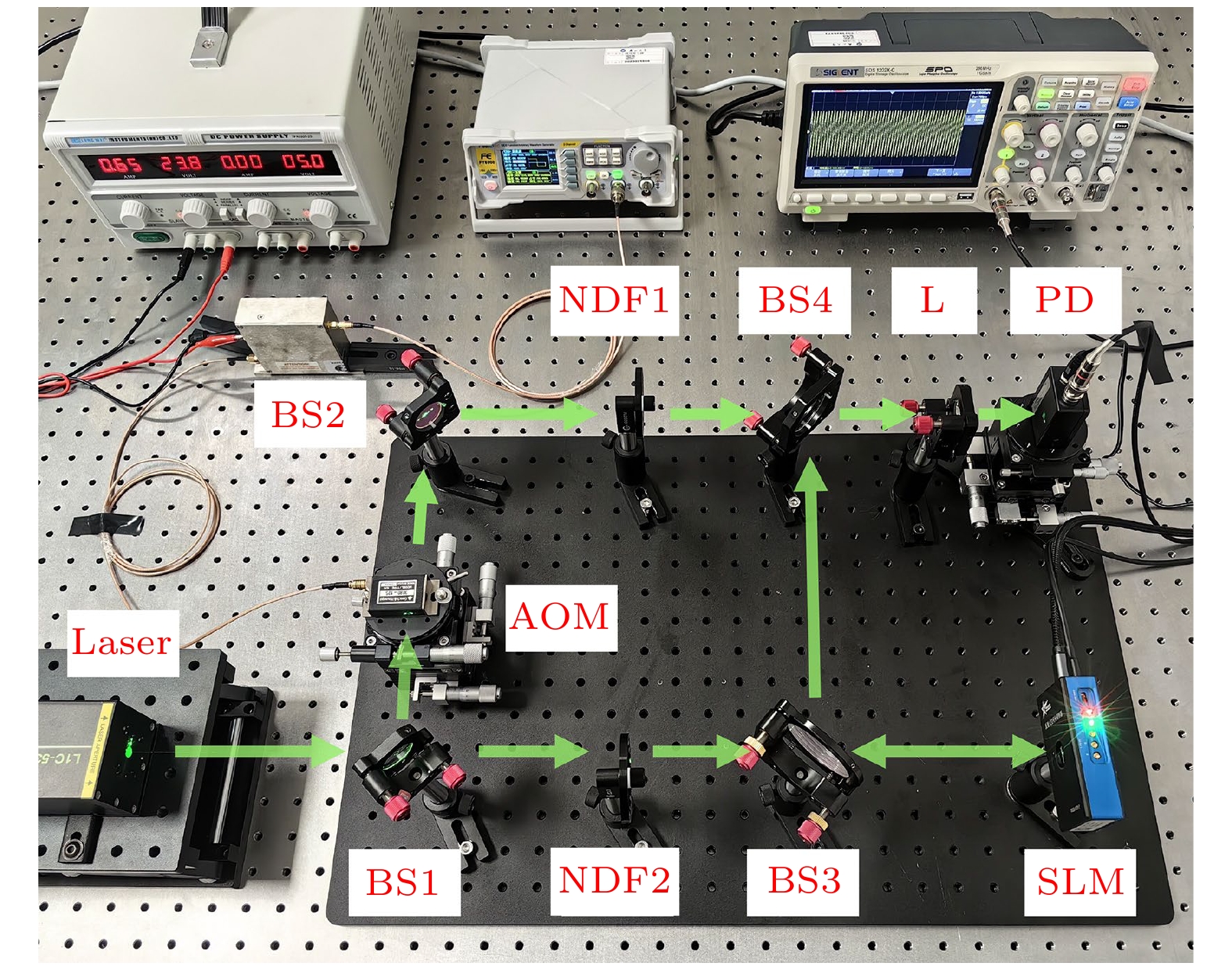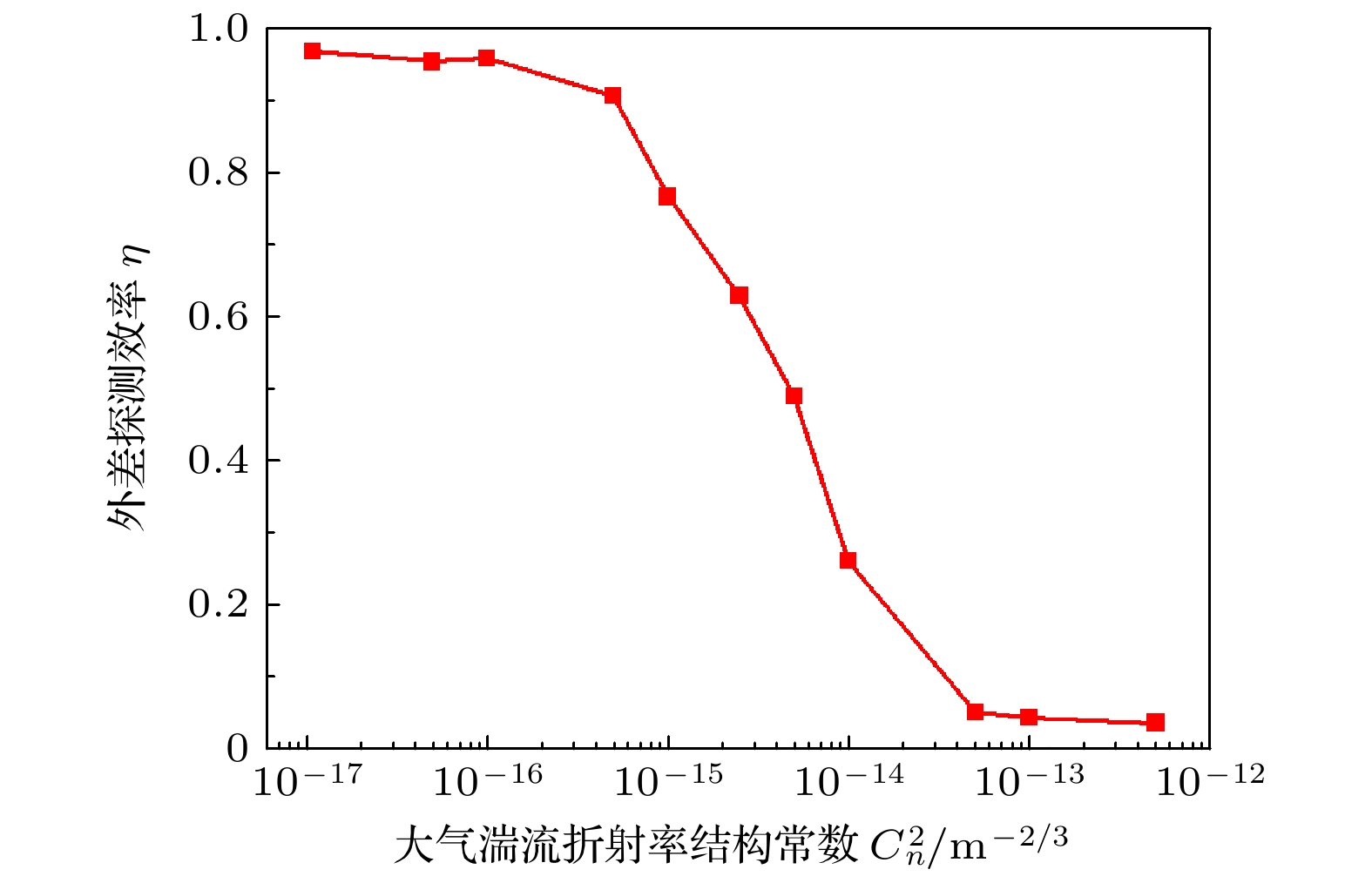-
空间相干光通信被认为是突破现有高速空间通信瓶颈的重要手段, 但其应用受到大气湍流的极大限制. 为此, 本文首先基于Huygens-Fresnel原理和低频补偿功率谱反演法, 研究了高斯光束经大气湍流传输后振幅和相位的随机分布特性; 然后, 利用相干混频效率及通信误码率模型, 获得大气湍流对空间相干光通信系统性能的影响规律; 最后, 搭建激光外差探测实验系统, 定量研究了大气湍流对空间相干光通信相干探测性能的影响. 结果表明: 弱湍流条件下, 空间相干光通信性能几乎不受大气湍流的影响; 中等强度湍流影响下, 相干混频效率会随着湍流强度的增大而迅速下降, 但通过提高单比特光子数可以有效抑制湍流对通信性能的负面影响; 强湍流会显著破坏光束相干性, 使得相干混频效率趋近于零, 即使提高单比特光子数也无法有效改善通信性能. 大气湍流是空间相干光通信发展的重要限制因素, 该研究可为空间相干光通信系统性能评估提供有益参考.Space coherent optical communication technology is considered to be an important way to overcome the bottleneck in current high-speed space communication. However, atmospheric turbulence seriously limits its realization. Based on the Huygens-Fresnel principle and the low-frequency compensation power spectrum inversion method, this work first investigates the random distribution characteristics of the amplitude and phase of a Gaussian beam after it has been transmitted through atmospheric turbulence. Then, using the coherent mixing efficiency and communication bit error rate model, the influence of atmospheric turbulence on the performance of spatial coherent optical communication systems is obtained. Finally, a laser heterodyne detection experimental system is built to quantitatively study the influence of atmospheric turbulence on the coherent detection performance of spatial coherent optical communication. The conclusions drawn from this study are as follows. 1) The spatial phase distortion caused by the weak turbulence channel is relatively small and will hardly affect the light intensity distribution characteristics of the Gaussian beam. In the case of weak turbulence, the influence of weak turbulence on the performance of coherent optical communication system is almost negligible. The communication bit error rate will decrease rapidly with the increase of the number of single bit data photons. The communication signal-to-noise ratio can be better than 10–5 when the number of single-bit photons is greater than 10. 2) Moderate turbulence will change the intensity distribution characteristics of the Gaussian beam, but will not cause a serious shift in the center of the spot. Under moderate turbulence conditions, the coherent mixing efficiency decreases rapidly as the turbulence intensity continues to increase, but the communication bit error rate still decreases rapidly with the increase of the number of single bit data photons. At this time, increasing the number of single-bit photons can suppress the negative influence of moderate intensity turbulence on the performance of coherent optical communication systems. 3) Strong turbulence will cause severe spatial phase distortion of the beam, destroy the consistency of the light intensity distribution, and cause a serious shift in the center of the spot. Under strong turbulence conditions, the coherent mixing efficiency of coherent optical communication systems approaches zero, and increasing the number of single bit data photons cannot significantly reduce the bit error rate, seriously affecting the quality of coherent optical communication. Atmospheric turbulence is an important limiting factor for developing space coherent optical communication. This study can provide useful references for evaluating the performance of space coherent optical communication systems.
-
Keywords:
- space coherent optical communication /
- atmospheric turbulence /
- mixing efficiency /
- bit error rate
[1] 李锐, 林宝军, 刘迎春, 沈苑, 董明佶, 赵帅, 孔陈杰, 刘恩权, 林夏 2023 红外与激光工程 52 20220393
 Google Scholar
Google Scholar
Li R, Lin B J, Liu Y C, Shen Y, Dong M J, Zhao S, Kong C J, Liu N Q, Lin X 2023 Infrared Laser Eng. 52 20220393
 Google Scholar
Google Scholar
[2] 张家铭 2023 光通信技术 47 37
 Google Scholar
Google Scholar
Zhang J M 2023 Opt. Commun. Technol. 47 37
 Google Scholar
Google Scholar
[3] Zhang T, Mao S, Fu Q, Cao G X, Su S, Jiang H L 2017 J. Laser Appl. 29 012013
 Google Scholar
Google Scholar
[4] Fu Q, Liu X, Jiang H L, Hu Y, Jiang L 2014 SPIE 9300 930029
[5] 高铎瑞, 谢壮, 马榕, 汪伟, 白兆峰, 郏帅威, 邵雯, 谢小平 2021 光子学报 50 0406001
Gao D R, Xie Z, Ma R, Wang W, Bai Z F, Jia S W, Shao W, Xie X P 2021 Acta Photon. Sin. 50 0406001
[6] Israel D J, Edwards B L, Staren J W 2017 IEEE Aerospace Conference Proceedings Big Sky, MT, USA, March 4–11, 2017 pp1–6
[7] Robinson B S, Shih T, Khatri F I, Boroson D M, Hogan M J 2018 Free-Space Laser Communication and Atmospheric Propagation XXX, San Francisco, USA, February 15, 2018 p105240S
[8] Gregory M, Heine F, Kämpfner H, Lange R, Saucke K, Sterr U, Meyer R 2010 Free-Space Laser Communication Technologies XXII, San Francisco, USA, February 26, 2010 75870E
[9] Hauschildt H, le Gallou N, Mezzasoma S, Ludwig Moeller H, Perdigues Armengol J, Witting M, Herrmann J, Carmona C 2018 International Conference on Space Optics, Chania, GREECE, October 09–12, 2018 p111800X
[10] Satoh Y, Miyamoto Y, Takano Y, Yamakawa S, Kohata H 2017 IEEE International Conference on Space Optical Systems and Applications (ICSOS), Okinawa, JAPAN, November 14–16, 2017, p240
[11] Munemasa Y, Kolev D R, Fuse T, Kubo-oka T, Kunimori H, Carrasco-Casado A, Takenaka H, Saito Y, Trinh P V, Suzuki K, Koyama Y, Toyoshima M 2018 Free-Space Laser Communication and Atmospheric Propagation XXX, San Francisco, USA, January 29–30, 2018 p105240F
[12] 任建迎, 孙华燕, 张来线, 张天齐 2019 激光与红外 49 143
 Google Scholar
Google Scholar
Ren J Y, Sun H Y, Zhang L X, Zhang T Q 2019 Laser Infr. 49 143
 Google Scholar
Google Scholar
[13] 崔岳, 唐勇 2020 国际太空 7 38
 Google Scholar
Google Scholar
Cui Y, Tang Y 2020 Space Int. 7 38
 Google Scholar
Google Scholar
[14] Wan Z S, Shen Y J, Wang Z Y, Shi Z J, Liu Q, Fu X 2022 Light Sci. Appl. 11 144
 Google Scholar
Google Scholar
[15] Wang L Q, Wang J C, Tang X Y, Chen H, Chen X 2022 Opt. Express 30 7854
 Google Scholar
Google Scholar
[16] 李艳玲, 梅海平, 任益充, 张骏昕, 陶志炜, 艾则孜姑丽⋅阿不都克热木, 刘世韦 2022 物理学报 71 140201
 Google Scholar
Google Scholar
Li Y L, Mei H P, Ren Y C, Zhang J X, Tao Z W, Aizeziguli A, Liu S W 2022 Acta Phys. Sin. 71 140201
 Google Scholar
Google Scholar
[17] Yang Y F, Yan C X, Hu C H, Wu C J 2017 Opt. Express 25 7567
 Google Scholar
Google Scholar
[18] Salem M, Rolland J P 2010 J. Opt. Soc. Am. A 27 1111
 Google Scholar
Google Scholar
[19] Liu Y, Gao M, Zeng X, Liu F, Bi W 2021 Opt. Laser Eng. 146 106694
 Google Scholar
Google Scholar
[20] Geng J N, Feng Z J, Cao C Q, Feng S M, Xu X K, Shang Y J, Wu Z Y, Yan X 2021 Opt. Express 29 39016
 Google Scholar
Google Scholar
[21] Zheng D H, Li Y, Zhou H H, Bian Y M, Yang C, Li W, Qiu J F, Guo H X, Hong X B, Zuo Y, Giles I P, Tong W J, Wu J 2018 Opt. Express 26 28879
 Google Scholar
Google Scholar
[22] Zhang H, Xu L, Guo Y F, Cao J T, Liu W, Yang L Q 2022 Opt. Express 30 7477
 Google Scholar
Google Scholar
[23] 孔英秀, 柯熙政, 杨媛 2015 激光与光电子学进展 52 95
Kong Y X, Ke X Z, Yang Y 2015 Laser Optoelectron Prog. 52 95
[24] Liu C, Chen S Q, Li X Y, Xian H 2014 Opt. Express 22 15554
 Google Scholar
Google Scholar
[25] Schmidt J D 2010 Numerical Simulation of Optical Wave Propagation with Examples in MATLAB (Bellingha: SPIE) pp157–163
[26] 艾则孜姑丽⋅阿不都克热木, 陶志炜, 刘世韦, 李艳玲, 饶瑞中, 任益充 2022 物理学报 71 234201
 Google Scholar
Google Scholar
Aizeziguli A, Tao Z W, Liu S W, Li Y L, Rao R Z, Ren Y C 2022 Acta Phys. Sin. 71 234201
 Google Scholar
Google Scholar
[27] 徐启伟, 王佩佩, 曾镇佳, 黄泽斌, 周新星, 刘俊敏, 李瑛, 陈书青, 范滇元 2020 物理学报 69 014209
 Google Scholar
Google Scholar
Xu Q W, Wang P P, Zeng Z J, Huang Z B, Zhou X X, Liu J M, Li Y, Chen S Q, Fan Z Y 2020 Acta Phys. Sin. 69 014209
 Google Scholar
Google Scholar
[28] 闫旭, 张文睿, 曹长庆, 冯喆珺 2021 光子学报 50 312
Yan X, Zhang W R, Cao C Q, Feng Z J 2021 Acta Photonica Sin. 50 312
[29] Wu Z Y, Cao C Q, Feng Z J, Wu X N, Duan C X 2023 Opt. Lett. 48 5257
 Google Scholar
Google Scholar
-
图 2 大气湍流相位屏仿真结果 (a)弱湍流$ C_n^2 $=2×10–17 m–2/3; (b)中湍流$ C_n^2 $=2×10–15 m–2/3; (c)强湍流$ C_n^2 $=2×10–13 m–2/3
Fig. 2. Simulation results of atmospheric turbulence phase screen: (a) Weak turbulence $ C_n^2 $=2×10–17 m–2/3; (b) moderate turbulence $ C_n^2 $=2×10–15 m–2/3; (c) strong turbulence $ C_n^2 $=2×10–13 m–2/3.
图 3 大气湍流扰动下的光强分布仿真结果 (a)弱湍流$ C_n^2 $=2×10–17 m–2/3; (b)中湍流$ C_n^2 $=2×10–15 m–2/3; (c)强湍流$ C_n^2 $=2×10–13 m–2/3
Fig. 3. Simulation results of light intensity distribution under atmospheric turbulence disturbance: (a) Weak turbulence $ C_n^2 $=2×10–17 m–2/3; (b) moderate turbulence $ C_n^2 $=2×10–15 m–2/3; (c) strong turbulence $ C_n^2 $=2×10–13 m–2/3.
-
[1] 李锐, 林宝军, 刘迎春, 沈苑, 董明佶, 赵帅, 孔陈杰, 刘恩权, 林夏 2023 红外与激光工程 52 20220393
 Google Scholar
Google Scholar
Li R, Lin B J, Liu Y C, Shen Y, Dong M J, Zhao S, Kong C J, Liu N Q, Lin X 2023 Infrared Laser Eng. 52 20220393
 Google Scholar
Google Scholar
[2] 张家铭 2023 光通信技术 47 37
 Google Scholar
Google Scholar
Zhang J M 2023 Opt. Commun. Technol. 47 37
 Google Scholar
Google Scholar
[3] Zhang T, Mao S, Fu Q, Cao G X, Su S, Jiang H L 2017 J. Laser Appl. 29 012013
 Google Scholar
Google Scholar
[4] Fu Q, Liu X, Jiang H L, Hu Y, Jiang L 2014 SPIE 9300 930029
[5] 高铎瑞, 谢壮, 马榕, 汪伟, 白兆峰, 郏帅威, 邵雯, 谢小平 2021 光子学报 50 0406001
Gao D R, Xie Z, Ma R, Wang W, Bai Z F, Jia S W, Shao W, Xie X P 2021 Acta Photon. Sin. 50 0406001
[6] Israel D J, Edwards B L, Staren J W 2017 IEEE Aerospace Conference Proceedings Big Sky, MT, USA, March 4–11, 2017 pp1–6
[7] Robinson B S, Shih T, Khatri F I, Boroson D M, Hogan M J 2018 Free-Space Laser Communication and Atmospheric Propagation XXX, San Francisco, USA, February 15, 2018 p105240S
[8] Gregory M, Heine F, Kämpfner H, Lange R, Saucke K, Sterr U, Meyer R 2010 Free-Space Laser Communication Technologies XXII, San Francisco, USA, February 26, 2010 75870E
[9] Hauschildt H, le Gallou N, Mezzasoma S, Ludwig Moeller H, Perdigues Armengol J, Witting M, Herrmann J, Carmona C 2018 International Conference on Space Optics, Chania, GREECE, October 09–12, 2018 p111800X
[10] Satoh Y, Miyamoto Y, Takano Y, Yamakawa S, Kohata H 2017 IEEE International Conference on Space Optical Systems and Applications (ICSOS), Okinawa, JAPAN, November 14–16, 2017, p240
[11] Munemasa Y, Kolev D R, Fuse T, Kubo-oka T, Kunimori H, Carrasco-Casado A, Takenaka H, Saito Y, Trinh P V, Suzuki K, Koyama Y, Toyoshima M 2018 Free-Space Laser Communication and Atmospheric Propagation XXX, San Francisco, USA, January 29–30, 2018 p105240F
[12] 任建迎, 孙华燕, 张来线, 张天齐 2019 激光与红外 49 143
 Google Scholar
Google Scholar
Ren J Y, Sun H Y, Zhang L X, Zhang T Q 2019 Laser Infr. 49 143
 Google Scholar
Google Scholar
[13] 崔岳, 唐勇 2020 国际太空 7 38
 Google Scholar
Google Scholar
Cui Y, Tang Y 2020 Space Int. 7 38
 Google Scholar
Google Scholar
[14] Wan Z S, Shen Y J, Wang Z Y, Shi Z J, Liu Q, Fu X 2022 Light Sci. Appl. 11 144
 Google Scholar
Google Scholar
[15] Wang L Q, Wang J C, Tang X Y, Chen H, Chen X 2022 Opt. Express 30 7854
 Google Scholar
Google Scholar
[16] 李艳玲, 梅海平, 任益充, 张骏昕, 陶志炜, 艾则孜姑丽⋅阿不都克热木, 刘世韦 2022 物理学报 71 140201
 Google Scholar
Google Scholar
Li Y L, Mei H P, Ren Y C, Zhang J X, Tao Z W, Aizeziguli A, Liu S W 2022 Acta Phys. Sin. 71 140201
 Google Scholar
Google Scholar
[17] Yang Y F, Yan C X, Hu C H, Wu C J 2017 Opt. Express 25 7567
 Google Scholar
Google Scholar
[18] Salem M, Rolland J P 2010 J. Opt. Soc. Am. A 27 1111
 Google Scholar
Google Scholar
[19] Liu Y, Gao M, Zeng X, Liu F, Bi W 2021 Opt. Laser Eng. 146 106694
 Google Scholar
Google Scholar
[20] Geng J N, Feng Z J, Cao C Q, Feng S M, Xu X K, Shang Y J, Wu Z Y, Yan X 2021 Opt. Express 29 39016
 Google Scholar
Google Scholar
[21] Zheng D H, Li Y, Zhou H H, Bian Y M, Yang C, Li W, Qiu J F, Guo H X, Hong X B, Zuo Y, Giles I P, Tong W J, Wu J 2018 Opt. Express 26 28879
 Google Scholar
Google Scholar
[22] Zhang H, Xu L, Guo Y F, Cao J T, Liu W, Yang L Q 2022 Opt. Express 30 7477
 Google Scholar
Google Scholar
[23] 孔英秀, 柯熙政, 杨媛 2015 激光与光电子学进展 52 95
Kong Y X, Ke X Z, Yang Y 2015 Laser Optoelectron Prog. 52 95
[24] Liu C, Chen S Q, Li X Y, Xian H 2014 Opt. Express 22 15554
 Google Scholar
Google Scholar
[25] Schmidt J D 2010 Numerical Simulation of Optical Wave Propagation with Examples in MATLAB (Bellingha: SPIE) pp157–163
[26] 艾则孜姑丽⋅阿不都克热木, 陶志炜, 刘世韦, 李艳玲, 饶瑞中, 任益充 2022 物理学报 71 234201
 Google Scholar
Google Scholar
Aizeziguli A, Tao Z W, Liu S W, Li Y L, Rao R Z, Ren Y C 2022 Acta Phys. Sin. 71 234201
 Google Scholar
Google Scholar
[27] 徐启伟, 王佩佩, 曾镇佳, 黄泽斌, 周新星, 刘俊敏, 李瑛, 陈书青, 范滇元 2020 物理学报 69 014209
 Google Scholar
Google Scholar
Xu Q W, Wang P P, Zeng Z J, Huang Z B, Zhou X X, Liu J M, Li Y, Chen S Q, Fan Z Y 2020 Acta Phys. Sin. 69 014209
 Google Scholar
Google Scholar
[28] 闫旭, 张文睿, 曹长庆, 冯喆珺 2021 光子学报 50 312
Yan X, Zhang W R, Cao C Q, Feng Z J 2021 Acta Photonica Sin. 50 312
[29] Wu Z Y, Cao C Q, Feng Z J, Wu X N, Duan C X 2023 Opt. Lett. 48 5257
 Google Scholar
Google Scholar
计量
- 文章访问数: 5751
- PDF下载量: 202
- 被引次数: 0















 下载:
下载:






